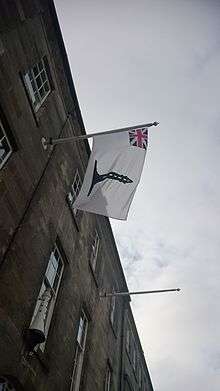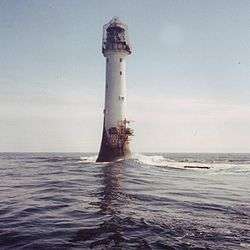Northern Lighthouse Board


The Northern Lighthouse Board (NLB) is the General Lighthouse Authority for Scotland and the Isle of Man. It is a non-departmental public body responsible for marine navigation aids around coastal areas.
History

The NLB was formed in 1786 as the Commissioners of Northern Light Houses by Act of Parliament largely at the urging of the lawyer and politician George Dempster ("Honest George"), to oversee the construction and operation of four Scottish lighthouses: Kinnaird Head, North Ronaldsay, Scalpay and Mull of Kintyre, for which they could borrow up to £1,200. Until this time, the only major lighthouse in Scotland was the coal brazier mounted on the Isle of May in the Firth of Forth together with some smaller lights in the approaches of the Tay and Clyde estuaries. None of the major passages around Scotland, which led through dangerous narrows, were marked.
The commissioners, whose first president was the Lord Provost of Edinburgh, Sir James Hunter-Blair, advertised for building estimates, but there were no takers. They received an offer of help from Ezekiel Walker of King's Lynn who had developed a parabolic reflector for the Hunstanton Lighthouse[1] and sent Thomas Smith, who was making his name in street lighting in Edinburgh and had offered help, to England to learn from him. Smith soon returned and instructed an Edinburgh architect to prepare the plans for four lighthouses.
The £1,200 was spent before the first light at Kinnaird Head was finished and a further act of Parliament was required which allowed them to receive half their dues before all the lights were finished. By the end of 1787 the first light had been installed. At the Mull of Kintyre everything had to be transported by pack horse from Campbeltown, 12 miles away, but it was lit by October 1788. To get to Scalpay in the Outer Hebrides and North Ronaldsay in the Orkney Isles needed boat trips across rough waters for Smith and Mills, the stonemason but all the same the job was completed by October 1789 to widespread praise. The dues which had originally been set at two shillings per ton of cargo in the seventeenth century were now reduced to one penny per ton.[2]
The Commissioners' most famous engineer was Robert Stevenson, whose sons David, Alan, and Thomas followed their father into the profession. The Stevenson dynasty built the majority of the Northern lights, in some exceptionally challenging locations. Their lights were some of the engineering masterpieces of their time, notably those at Bell Rock, Skerryvore and Muckle Flugga.
Between 1876 and 2005 the NLB also maintained foghorns at a number of locations. The last (at Skerryvore) was sounded for the last time on 4 October 2005.[3]
Operations
The board is based at its Georgian headquarters building in George Street in the centre of Edinburgh from where it remotely monitors its network. Technical operations are carried out from a base in Oban, Argyll and Bute, where there are maintenance workshops and facilities for the construction of buoys and beacons. The NLBs vessels are also based here. The Oban depot has been recently modernised.
Under the terms of the Scotland Act 1998, the NLB is not a devolved body and thus remains directly accountable to the UK Secretary of State for Transport. In practice, close co-operation is made with both the Scottish Government and the Isle of Man Government. The NLB is funded by pooled light dues administered by the UK's Department of Transport and distributed to the NLB, Trinity House and Commissioners of Irish Lights.
Assets
As of 31 March 2015, the NLB operates the following:[4]
Navigational devices
Statutory
- 206 lighthouses, sub-divided as:
- 66 with a range of 15 nautical miles or more
- 140 with a range of 15 nautical miles or less
- 167 lit buoys (and 37 spare buoys)
- 23 beacons
- 4 DGPS stations (and monitoring an additional 2 stations)
- 29 radar beacons[lower-alpha 1], sub-divided as:
- 22 on lighthouses
- 9 on buoys
- 47 Automatic identification system units, sub-divided as
- 26 on lighthouses (and monitoring an additional 1 unit)
- 20 on buoys
- 1 Virtual AIS unit
- 206 lighthouses, sub-divided as:
Contract
- 3 lighthouses (and 2 in Norwegian waters)
- 104 buoys
- 0 fog signals
- 4 radar beacons (and 3 in Norwegian waters)
Local Authority
- 1080 light stations
- 712 buoy stations
Vessels
The NLB operates two lighthouse tenders, known by the prefix Northern Lighthouse Vessel, or NLV. NLV Pole Star has been in service since 2000 and NLV Pharos was delivered on 31 March 2007 to the Oban depot.[6] This will be the tenth Pharos, replacing the ninth Pharos which was sold in September 2006 for use as a Fishery Protection vessel for South Georgia and the South Sandwich Islands.
The Commissioners
Most of the Commissioners have always been ex officio appointments. The original Commissioners appointed in 1786 were the Scottish law agents of the Crown, the Sheriffs of Scotland's coastal counties, and the Provosts and Lord Provosts of Scottish cities and towns with strong mercantile interests. Reform of local government and sherriffdoms have since resulted in changes. Previous Commissioners include Richard Vary Campbell (1840-1901).[7]
The current Commissioners of Northern Lighthouses, as provided by Schedule 8 to the Merchant Shipping Act 1995, are the Lord Advocate and the Solicitor General for Scotland; the Lords Provost of Edinburgh, Glasgow and Aberdeen, the conveners of Highland Council and Argyll and Bute Council; the Sheriffs Principal of all the sheriffdoms in Scotland; a Manx representative nominated by the Lieutenant Governor of the Isle of Man and appointed by the Secretary of State; and up to five co-opted Commissioners.
Flags

The NLB uses two flags, an ensign and a Commissioners' Flag. The ensign is a Blue Ensign defaced with a white lighthouse in the fly, and is for general use. The Commissioners' flag, a plain White Ensign with a pre-1801 Union Flag in the canton, defaced with a blue lighthouse in the fly, is the only British flag to still use the pre-1801 Union Flag.[8] This flag is only flown from vessels with Commissioners aboard.
The Board HQ flies the Commissioner's flag, alongside the Saltire and the Isle of Man flag.[9]
See also
- List of Northern Lighthouse Board lighthouses - current operational NLB lighthouses
- List of lighthouses in Scotland - includes lighthouses formerly or never owned by the NLB
- Commissioners of Irish Lights - responsible for aids to navigation around all of Ireland
- Trinity House - responsible for aids to navigation around England, Wales, the Channel Islands and Gibraltar
- Richard Henry Brunton, the Scottish "Father of Japanese lighthouses"
References
Notes
- ↑ Three sites have more than one radar beacon
Citations
- ↑ Hillen, Henry J (1907). History of the Borough of King's Lynn. vol II. p. 461. Retrieved Jul 19, 2015.
- ↑ Allardyce, Keith; Hood, Evelyn M (1986). At Scotland' Edge: A celebration of the lighthouse service of Scotland and the Isle of Man. Glasgow and London: William Collins Sons & Co. pp. 10–18.
- ↑ "Sounding Out". Northern Lighthouse Board. Archived from the original on 2008-03-03. Retrieved 20 February 2010.
- ↑ "Northern Lighthouse Board - Annual Report and Accounts to 31 March 2015" (PDF). Northern Lighthouse Board. 15 July 2015. Retrieved 1 December 2016.
- ↑ "NOTICE TO MARINERS - 24 of 2015". Northern Lighthouse Board. December 2015. Retrieved 1 December 2016.
- ↑ "MV Pharos". Northern Lighthouse Board. Archived from the original on 2009-09-19. Retrieved 20 February 2010.
- ↑ https://www.royalsoced.org.uk/cms/files/fellows/biographical_index/fells_indexp1.pdf
- ↑ "Northern Lighthouse Commissioner's Flag". Flags of the World. Retrieved 20 February 2010.
- ↑ "Northern Lighthouse Board". britishflags.net.
External links
- Northern Lighthouse Board
- Lighthouse Library
- Pharos 1958 1963 Pharos (archive films about the Northern Lighthouse Board ship ‘Pharos VIII’ - from the National Library of Scotland: Scottish Screen Archive)
Coordinates: 55°57′10″N 3°12′05″W / 55.9527°N 3.2014°W
